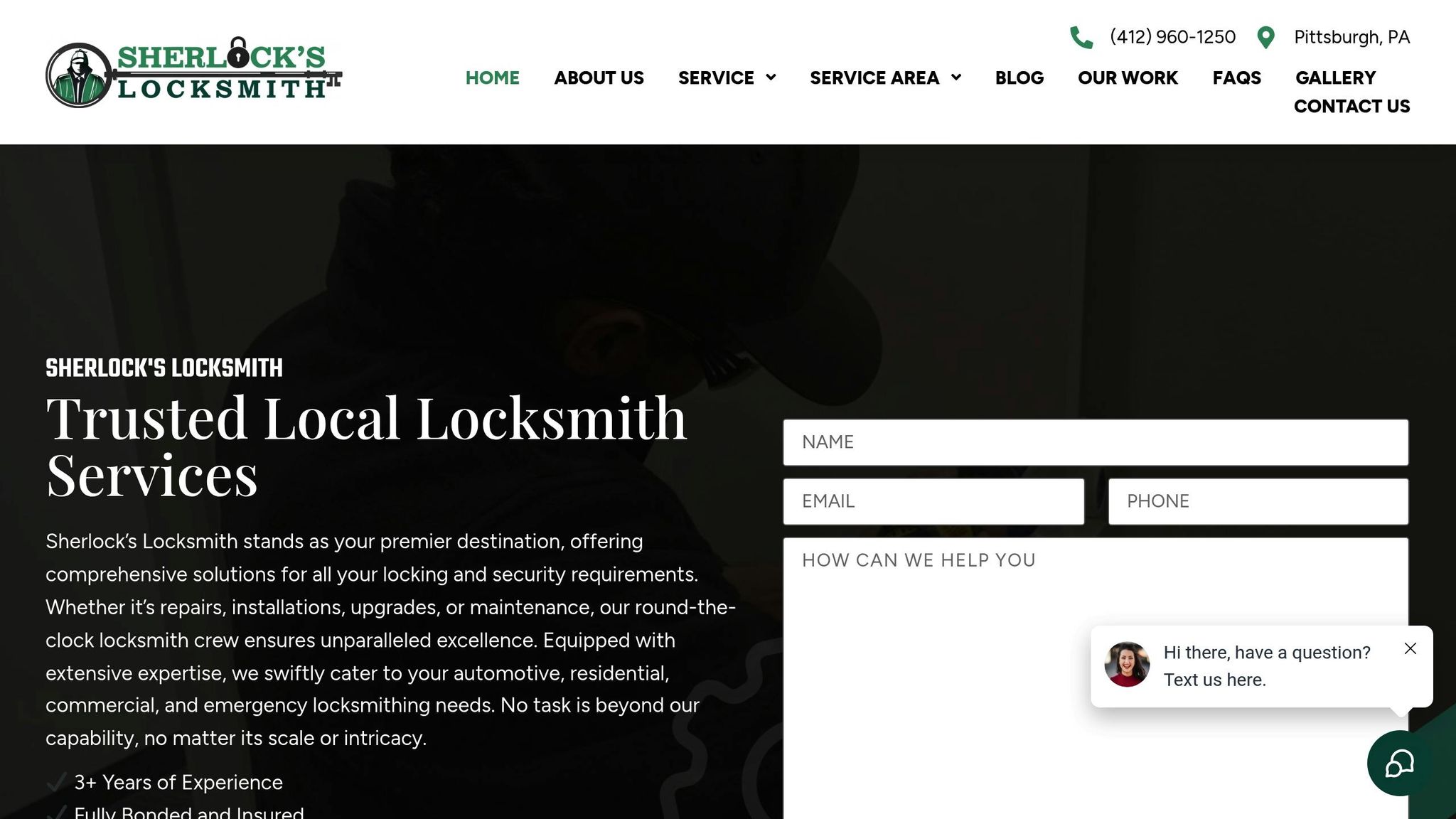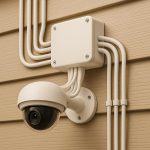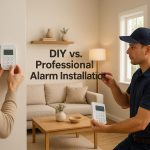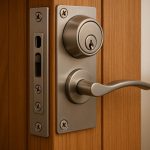Keyless entry systems let you unlock doors without traditional keys, using methods like keypads, smart cards, apps, or biometric scanners. They’re popular for their security and convenience, reducing risks like lost keys or unauthorized duplication. These systems can also integrate with home automation for remote control and monitoring.
Professional locksmiths ensure proper installation through a three-step process:
- Assessment: Inspect your door’s condition and compatibility.
- Hardware Installation: Replace old locks, align components, and handle wiring.
- Programming and Testing: Set up codes, pair devices, and verify functionality.
They use tools like drills, screwdrivers, wire strippers, and advanced equipment for smart locks, such as signal analyzers and programming software. Regular maintenance, like replacing batteries and updating firmware, keeps these systems running smoothly.
Hiring a locksmith ensures accurate installation, reliability, and support. For example, Sherlock’s Locksmith in Pittsburgh offers 24/7 services, from installation to troubleshooting. Whether for homes, offices, or vehicles, keyless systems improve access control and simplify security management.
Keypad Lock Installation – Keyless Entry
Professional Locksmith Installation Process
When it comes to installing keyless entry systems, professional locksmiths stick to a well-structured process. This approach ensures both the security and reliability of the system, while minimizing risks like malfunctions or vulnerabilities caused by improper installation.
Assessment and Preparation
The process kicks off with a detailed evaluation of your door and its current security setup. Locksmiths examine the door’s material, thickness, and overall condition to confirm compatibility with the selected keyless entry system. After all, even the most advanced lock can’t secure a door that’s weak or compromised.
"The level of security achieved is also dependent on your door." – Lockmart
If the door isn’t sturdy enough, locksmiths might suggest reinforcing it or even replacing it to ensure it can handle a high-security system. They also check the backset (the distance from the door’s edge to the center of the lock hole) and inspect the existing hardware layout.
Safety is a top priority during preparation. For smart locks requiring electrical connections, locksmiths turn off the power to the work area to avoid any risk of electrical shock. They also gather all the tools and components needed, so the installation proceeds smoothly without interruptions.
Installing Keyless Hardware
With the prep work done, locksmiths carefully remove the existing lock hardware, ensuring the door remains undamaged. If modifications are needed, they use precise measurements and specialized tools to maintain the door’s structural integrity.
Installing the new keyless hardware involves accurate alignment and secure positioning of all components. For smart locks, they properly route and protect the wiring to shield it from weather damage. They also ensure the power source is set up in compliance with local building codes. Special attention is given to strike plate alignment, as even minor misalignments can cause malfunctions or wear over time.
For battery-operated systems, locksmiths ensure that batteries can be easily replaced in the future. For hardwired systems, they make secure electrical connections that meet safety standards.
Programming and Testing
The final step is programming and testing the system. Locksmiths set up access codes, pair smart devices, and, if applicable, integrate the lock with existing home automation systems. This stage ensures every feature works as it should.
They test all functions multiple times, including emergency override options and backup access methods. For smart locks, they verify connectivity and confirm seamless integration with mobile apps. The goal is to ensure the system responds accurately to authorized users while blocking unauthorized attempts.
To wrap things up, locksmiths demonstrate the system’s features, showing you how to operate it, change access codes, and perform basic maintenance. They also offer tips for troubleshooting common issues and advise on when to seek professional help for repairs or adjustments.
Tools and Equipment Used by Professional Locksmiths
When it comes to installing keyless entry systems, professional locksmiths rely on a mix of traditional tools and modern technology to get the job done right. These tools are designed to handle the precision and complexity of today’s lock systems, ensuring proper installation, smooth operation, and lasting reliability.
Basic Tools for Installation
Every locksmith’s toolkit starts with the essentials. For instance, precision drill bits are a must for preparing doors to standard specifications – like the 2-1/8-inch holes for lock cylinders and 1-inch holes for deadbolts. Paired with variable-speed drills, these tools allow locksmiths to work with a variety of door materials, from softwood to reinforced steel, without sacrificing control.
Accurate measurements are critical, so tools like tape measures, calipers, and door prep jigs come into play. A door scope or thickness gauge helps locksmiths measure the exact dimensions of a door, ensuring they select the right lock components for the job.
Screwdrivers – both flathead and Phillips head – are indispensable. Many locksmiths prefer magnetic-tip screwdrivers to keep screws in place during installation. For added precision, torque screwdrivers are used to tighten screws to the manufacturer’s specifications, avoiding damage to sensitive electronic parts.
When it comes to wiring, tools like wire strippers and electrical tape are standard. Voltage testers ensure the power is safely disconnected before starting work on hardwired systems, while fish tape helps guide wiring through walls and door frames without causing unnecessary damage.
These basic tools lay the groundwork, but handling smart lock systems requires a more advanced set of equipment.
Specialized Equipment for Smart Locks
Installing and troubleshooting smart locks involves cutting-edge tools designed for electronic systems. For example, digital multimeters are used to test electrical continuity, measure voltage, and diagnose power supply issues. Locksmiths also rely on programming tablets or smartphones loaded with manufacturer-specific apps to configure access codes, set user permissions, and integrate locks with home automation systems.
To ensure reliable wireless performance, locksmiths use signal strength meters and Wi-Fi analyzers. These tools help optimize connectivity by identifying the best frequency channels and detecting interference that might disrupt the lock’s operation. For Bluetooth-enabled locks, Bluetooth signal analyzers are essential for verifying pairing and communication range.
For more advanced troubleshooting, locksmiths turn to oscilloscopes, which can pinpoint timing issues, signal distortions, or component failures within the lock’s circuitry. Battery load testers are another key tool, ensuring that power sources can handle the lock’s electrical demands over time – especially critical for battery-operated systems.
Specialized lock programming software and diagnostic interfaces allow locksmiths to access advanced settings, update firmware, and run system diagnostics. Some manufacturers even provide proprietary tools to unlock features not available through standard user interfaces.
Finally, thermal imaging is used to detect heat buildup in electronic components, helping locksmiths identify potential failures before they become problems. This proactive approach not only ensures the system’s reliability but also reduces the likelihood of follow-up service calls.
sbb-itb-643e28e
Why Hire Professional Locksmiths for Installation
Installing a keyless entry system isn’t just about swapping out a lock – it requires a deep understanding of both traditional and modern security systems. That’s where professional locksmiths come in. Their expertise ensures your system is not only installed correctly but also functions seamlessly.
Expertise and Precision
Professional locksmiths bring a level of precision that’s hard to match. Using advanced tools and industry-approved methods, they ensure everything is aligned and integrated perfectly. This attention to detail minimizes the risk of errors, which could otherwise compromise your system’s functionality or security.
Troubleshooting and Customization
Every property is unique, and so are its security needs. Skilled locksmiths can quickly address any installation challenges and customize the system to fit your specific requirements. Whether it’s integrating the keyless entry system with your existing setup or tailoring it to meet your preferences, their expertise ensures everything works together smoothly.
Sherlock’s Locksmith Services

If you’re in Pittsburgh, PA, Sherlock’s Locksmith is a trusted name for keyless entry installations. Their certified technicians combine years of traditional locksmithing experience with cutting-edge electronic security knowledge. From initial installation to final programming and user training, they handle every step with care and professionalism.
Sherlock’s Locksmith also provides ongoing support to make sure you get the most out of your new system. This includes guidance on system operation, maintenance tips, and troubleshooting advice, ensuring your investment in a keyless entry system is both secure and long-lasting. Plus, with 24/7 mobile support, help is always just a call away.
Maintenance and Troubleshooting of Keyless Entry Systems
Keeping your keyless entry system in top shape is essential for maintaining its security and performance over time. Like any other electronic system, regular care ensures it continues to function smoothly. Below are some practical tips to help you maintain your system and address common issues efficiently.
Routine Maintenance Tips
- Battery Management: Key fobs and electronic locks depend on batteries, so it’s crucial to replace them every 1–2 years. Keep spare batteries handy and set up a schedule to replace them consistently across all components. Simple steps like setting reminders to check batteries can prevent unexpected lockouts.
- Software and Firmware Updates: Keeping your system updated is a must. Regular updates not only fix vulnerabilities but also enhance functionality. Check the mobile app or the manufacturer’s website frequently for the latest updates.
- Credential Management: Protect your system by using strong, unique passwords for connected apps and enabling two-factor authentication whenever possible. For keypads, regularly update access codes to ensure security.
- Care for Key Fobs: Handle key fobs with care – keep them away from water, extreme temperatures, and physical impacts. A protective case can help prevent damage, and storing them away from other electronics reduces interference.
- System Monitoring: Check activity logs periodically for any unusual patterns or unauthorized access attempts.
- Backup Solutions: Always keep a spare physical key as a backup option for emergencies.
Common Issues and Solutions
Even with proper maintenance, occasional issues can arise. If your keyless entry system starts acting up, here’s what you can do:
- Check the Batteries: Ensure the batteries in your key fob or lock are fresh. Dead or weak batteries are a common culprit behind unresponsiveness.
- Update Software: Verify that your system’s software or firmware is up to date. Outdated software can lead to glitches or reduced functionality.
- Secure Credentials: Double-check that your passwords and access codes haven’t been compromised. Update them if needed.
- Review Activity Logs: Look through the system’s logs for any unusual activity or errors that might provide clues about the issue.
If these steps don’t resolve the problem, it’s a good idea to consult a professional. A trained technician can perform an in-depth inspection to identify and fix any hidden issues.
Conclusion
Setting up a keyless entry system requires careful planning, precise installation, and consistent maintenance to ensure long-term security. As outlined earlier, the process typically involves a detailed initial assessment, replacing outdated hardware, installing new components, and completing the setup with proper configuration and testing.
Keyless entry systems bring both convenience and added security, but their complexity makes professional installation a smart choice. Certified locksmiths have the skills to handle every step, from evaluation to programming, ensuring your system operates smoothly right from the start. They can also troubleshoot issues and tailor the system to meet your unique security requirements.
Sherlock’s Locksmith provides expert keyless entry installation services across Pittsburgh, PA. Their certified technicians are equipped with advanced tools and are available 24/7 to assist with residential, commercial, or automotive needs. Whether you need installation or ongoing support, their mobile locksmith team is ready to help.
To keep your system running efficiently, regular tasks like battery replacement, software updates, and credential management are essential. And when unexpected problems arise, having a reliable locksmith on call is invaluable. Rely on trusted professionals like Sherlock’s Locksmith to ensure your keyless entry system remains secure and dependable.
FAQs
Why should I hire a professional locksmith to install a keyless entry system instead of doing it myself?
Hiring a professional locksmith to set up your keyless entry system guarantees it’s done accurately, securely, and without hassle. These experts understand how to handle different lock types and advanced features, like auto-locking and tamper alerts, reducing the chances of mistakes or weak points in your security.
Beyond installation, locksmiths can offer personalized recommendations to match your unique security requirements, guiding you toward the best system for your home or business. Trusting a professional not only helps you avoid expensive errors but also ensures your property is safeguarded with a system installed the right way.
How do locksmiths make sure a keyless entry system works with my door and security setup?
Locksmiths play a crucial role in making sure your new keyless entry system works perfectly with your door and security setup. They start by inspecting your door hardware to confirm it can handle the new system, taking measurements and aligning components to ensure everything fits just right. If the system requires wiring or a power source, they’ll carefully check those as well.
On top of that, locksmiths evaluate the system’s connectivity features to make sure it integrates smoothly with any existing security measures or smart home devices you might have. This thorough approach ensures your keyless entry system operates without a hitch while boosting your overall security.
What should I do if my keyless entry system isn’t working, and how can I keep it in good condition?
If your keyless entry system stops working, start by checking the battery in your key fob – it might just need a quick replacement. Also, ensure your vehicle’s main battery is fully charged, as low power can often cause the system to malfunction. If that doesn’t solve the problem, take a closer look at the keypad, receiver, and wiring for any visible damage or loose connections. For more complex issues, you might need to call in a professional to diagnose and fix the problem.
To keep your keyless entry system running smoothly, give it a little TLC. Clean the components regularly to prevent dirt buildup, double-check that all wiring stays securely in place, and consider scheduling routine maintenance with a locksmith. A little preventive care goes a long way in avoiding unexpected headaches and keeping your system reliable for years.









